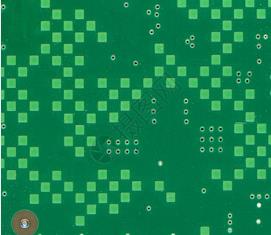The principles to be followed in the PCB design of the control board are as follows:
1. In the layout of PCB components, the components related to each other should be placed as close as possible. For example, clock generators, crystal oscillators, and clock input terminals of the CPU are all prone to noise, so they should be placed closer. For those devices that are prone to noise, low-current circuits, high-current circuit switching circuits, etc., keep them away from the logic control circuit and storage circuit (ROM, RAM) of the single-chip microcomputer as much as possible. If possible, these circuits can be made into circuits. Board, this is conducive to anti-interference and improve the reliability of circuit work.
Second, try to install decoupling capacitors next to the key components, such as ROM, RAM and other chips. In fact, printed circuit board traces, pin connections and wiring, etc. may contain large inductance effects. Large inductance may cause severe switching noise spikes on the Vcc trace. The only way to prevent switching noise spikes on Vcc traces is to place a 0.1uF electronic decoupling capacitor between VCC and power ground. If surface mount components are used on the circuit board, chip capacitors can be used directly against the components and fixed on the Vcc pin.

It is best to use ceramic capacitors, because this type of capacitor has low electrostatic loss (ESL) and high frequency impedance, and the temperature and time of the dielectric stability of this type of capacitor are also very good. Try not to use tantalum capacitors, because their impedance is higher at high frequencies.
Pay attention to the following points when placing decoupling capacitors:
1. Connect a 100uF electrolytic capacitor across the power input end of the printed circuit board. If the volume permits, a larger capacitance is better.
2. In principle, a 0.01uF ceramic capacitor needs to be placed next to each integrated circuit chip. If the gap of the circuit board copy board is too small to be placed, you can place a 1-10 tantalum capacitor for every 10 chips. .
3. For components with weak anti-interference ability and large current changes when turned off, and storage components such as RAM and ROM, a decoupling capacitor should be connected between the power line (Vcc) and the ground line.
4. The lead of the capacitor should not be too long, especially the high-frequency bypass capacitor can not take the lead.
Three. In the single-chip microcomputer control system, there are many types of ground wires, such as systematic ground, shield ground, logic ground, analog ground, etc. The reasonable layout of the ground wire will determine the anti-interference ability of the circuit board. When designing ground wires and grounding points, the following issues should be considered:
1. Logic ground and analog ground should be wired separately and cannot be used together. Connect their respective ground wires to the corresponding power ground wires. When designing, the analog ground wire should be as thick as possible, and the grounding area of the terminal should be enlarged as much as possible. Generally speaking, it is best to isolate the input and output analog signals from the microcontroller circuit through optocouplers.
2. When designing the printed circuit board of the logic circuit, the ground wire should form a closed loop form to improve the anti-interference ability of the circuit.
3. The ground wire should be as thick as possible. If the ground wire is very thin, the resistance of the ground wire will be large, causing the ground potential to change with the current change, causing the signal level to be unstable, and the anti-interference ability of the circuit is reduced. If the wiring space allows, ensure that the width of the main ground wire is at least 2 to 3 mm, and the ground wire on the component pin should be about 1.5 mm.
4. Pay attention to the choice of grounding point. When the signal frequency on the circuit board is lower than 1MHz, because the electromagnetic induction between wiring and components has little effect, and the circulating current formed by the grounding circuit has a greater impact on interference, it is necessary to use a point of grounding so that it does not form a loop. When the signal frequency on the circuit board is higher than 10MHz, due to the obvious inductance effect of the wiring, the ground line impedance becomes very large. At this time, the circulating current formed by the grounding circuit is no longer a major problem. Therefore, multi-point grounding should be used to reduce the ground impedance as much as possible.
5. In addition to the layout of the power line, the width of the trace should be increased as much as possible according to the size of the current. When wiring, the routing direction of the power line and the ground line should be consistent with the routing of the data line. At the end of the wiring work, Use ground wires to cover the circuit board bottom where there are no traces. These methods all help to enhance the anti-interference ability of the circuit.
6. The width of the data line should be as wide as possible to reduce impedance. The width of the data line is at least not less than 0.3mm (12mil), and it is more ideal if it is 0.46~0.5mm (18mil~20mil).